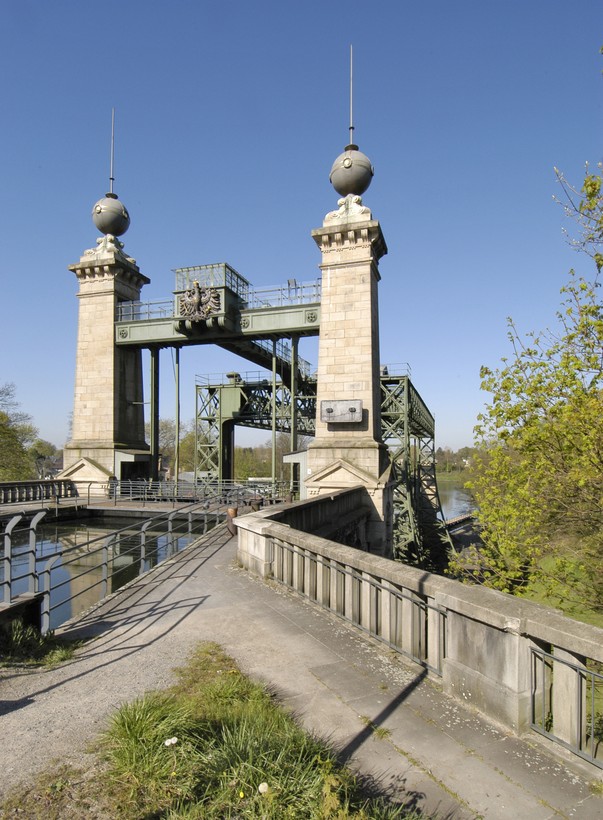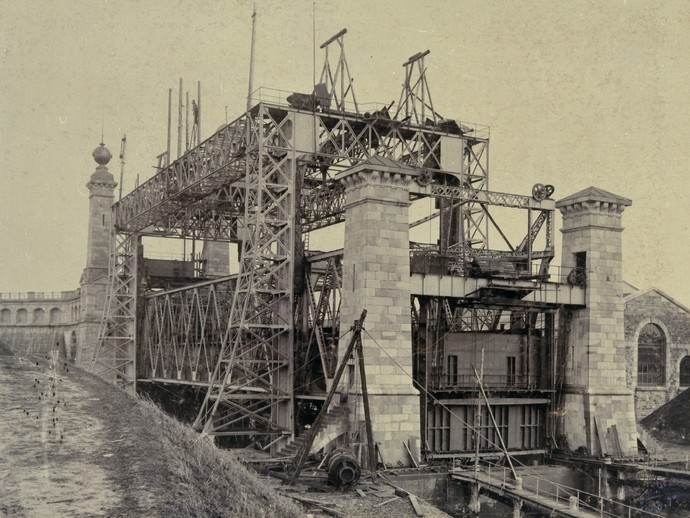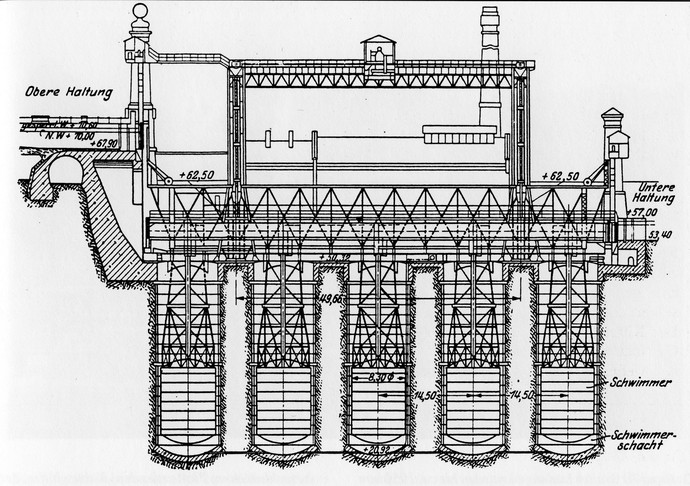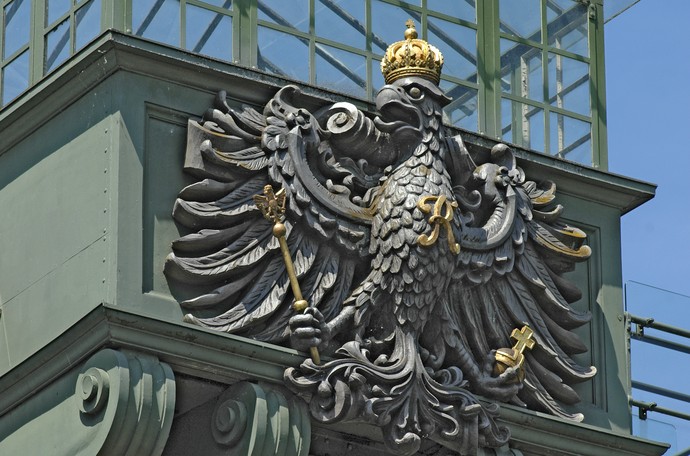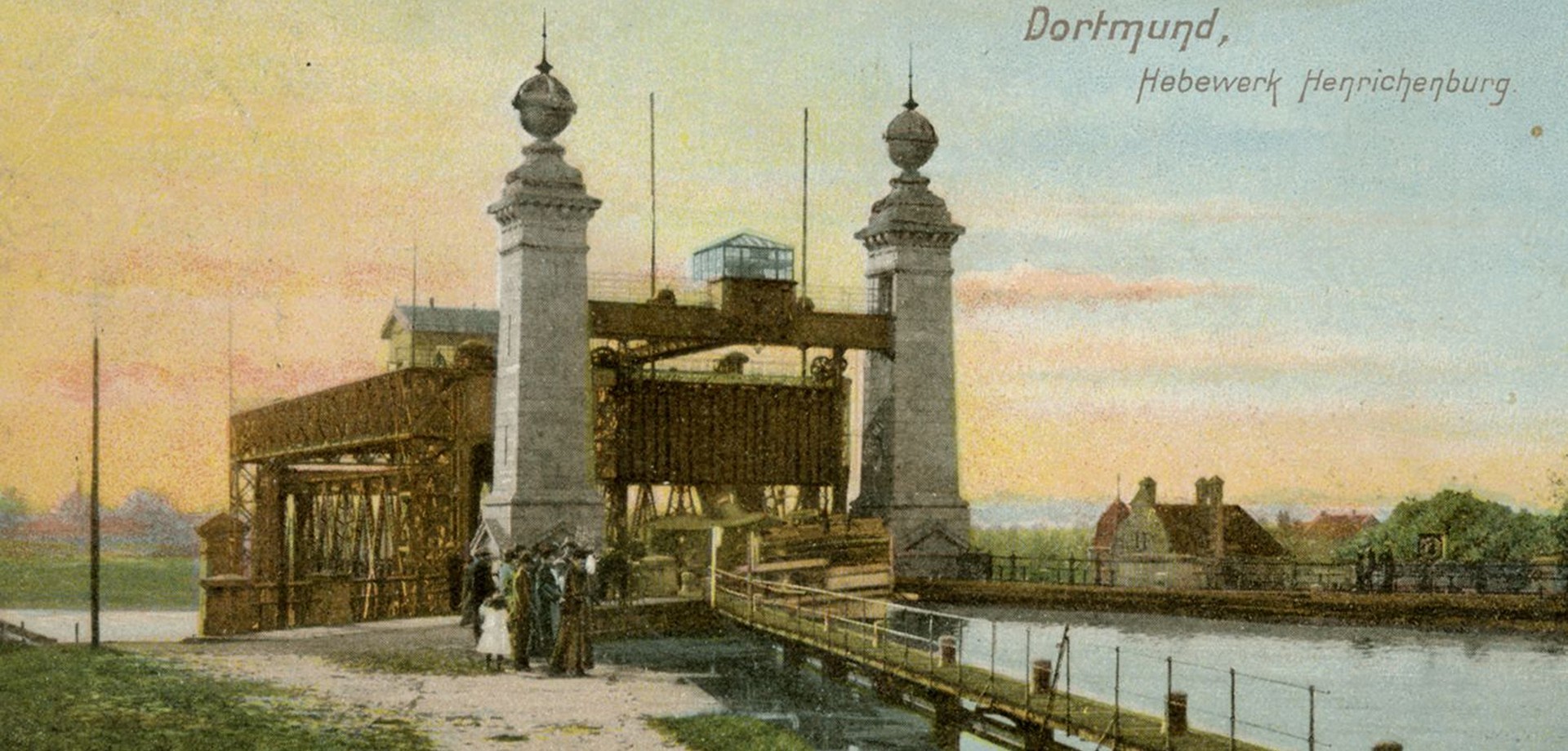
Colour postcard of the boat lift, c. 1900
From Masterpiece to Museum
The “Schiffshebewerk Henrichenburg” was a vital structure along the Dortmund-Ems Canal. Only after its completion could ships traverse to the port of Dortmund. It remains the largest and most spectacular structure on the Dortmund-Ems Canal. Once a masterpiece of engineering, its stately presence continues to attract visitors.
Origins of the Shiplift
With its decision to build a state-of-the-art shiplift, Prussia set a visually striking precedent. Its railways had been struggling to handle bulk transport of goods to and from seaports. To support the Ruhr Region’s growing coal and steel industry, Prussia needed to develop another high-capacity transport system: inland water transport. The Mittelland Canal (Mittellandkanal) was thus proposed to link transport among the Oder, Elbe, Weser, Ems, and Rhine rivers.
The project sparked competing interests. The East Elbian “Junker,” conservative representatives of agriculture, rejected the building plans, as did the representatives of heavy industry from Saarland and Silesia. To bypass resistance, the Prussian government focused its efforts on completing the initial phase of the project, the Dortmund-Ems Canal: coal for Emden, ore for Dortmund’s coal and steel hub. Despite criticism from experts, additional concessions to the opposition were made placing limits on ship size (67-metre length, 8.20-metre width, 2-metre draught).
Commencement held by Kaiser Wilhelm II
Celebrations on August 11th, 1899 marked the inauguration of the Dortmund-Ems Canal. Prussian King Wilhelm II used the occasion to address opponents of the project: ‘This canal will only take full effect in combination with the Mittelland Canal, which my government is steadfastly determined to tackle. (Bravo).’ The fight for the Mittelland Canal waged on.
With assistance from the “Schiffshebewerk Henrichenburg,” ships could now traverse a 14-metre-high differential. Its construction involved both financial and technical considerations. The shiplift design was more cost-effective than the previously planned lock staircase made of two or three locks.
The “Schiffshebewerk Henrichenburg” was technologically groundbreaking. It was the first shiplift to implement a multi-float hoist and could bear a total weight of approximately 3,100 tonnes. Ships with load capacities up to 750 tonnes could be lifted. During the latter half of the 19th century, vertical shiplifts in England, France and Belgium could only raise ships weighing up to 400 tonnes; these lifts used pistons operating on the basis of hydraulic principles. A novel feature of the “Schiffshebewerk Henrichenburg” was its use of four spindles that direct the ship’s trough vertically (patented by F. Jebens). Technical uses of buoyancy, nevertheless, have been known since antiquity (Archimedes’ principle).
The “Schiffshebewerk Henrichenburg” was not the first float-based lift in the world. At the end of the 18th century experimental installations had already been built in England: a single-float lift made by Rowland & Pickering and Robert Weldon’s immersion lock design for a small vessel canal system. In 1806, Charles Faurey constructed a single-float lift based on English prototypes on the Canal du Creusot, a branch canal along the Canal du Centre in France. Around 1900, after the “Schiffshebewerk Henrichenburg” successfully began operating, international debate peaked among engineers over which method of lifting vessels, vertical lift or inclined plane, was most effective.
The principle of the float lift
Enthusiasm for building the first shiplift for large inland vessels inspired engineers of the era. Accordingly, the Ministry of Public Works initially sought its own design, advertising the prestigious project domestically and abroad. Subsequent criticism and protest from excluded parties opened the project to private sector participation. They launched a limited competition. Five major engineering firms and shipyards competed, submitting ten distinct designs for vertical lifts and inclined planes. The winning bid came from Haniel & Lueg. In the spring of 1894, the Ministry of Public Works commissioned the construction of the Shiplift.
Chief engineer Gerdau vividly explained the core principle of a flotation hoist:
“Lifting this weight to a height of 16 [!] metres would, of course, require an enormous amount of force. To prevent that, one must look for a force that constantly pushes the weight upward without added effort. You might imagine a great deal of balloons attached to a ship’s trough, lifting its weight and keeping it afloat; but of course, that’s not practically feasible. Yet, the same effect is achieved if you picture a series of large iron balloons or floats, entirely submerged in water, propping up sturdy pillars on which a ship’s trough is perched. The buoyancy of the floats completely offsets the weight of the trough, allowing it to be moved up and down with ease.”
On this flotation lift, the trough sits atop five air-filled chambers (floats) that are submerged within five water-filled shafts. The downward force of the trough, its supporting pillars, and the floats is offset by the upward force of buoyancy. The volume of the air-filled floats determines the magnitude of the buoyant force. Even a slight increase or decrease of water in the trough will cause it to move up or down. A central electric motor powers four guide spindles, each 24.6 metres long. These spindles moderate lifting and lowering operations, ensuring that the ship’s trough remains perfectly level at all times.
Aside from minor technical issues, the lift fulfilled all expectations. It went on to become a vital hub for coordinating shipping and waterway operations. After its completion, a housing settlement for employees was built on the south side of the canal, and a separate residence for the department head was constructed on the north side. The site quickly drew an influx of construction and industry tourism.
‘Stone Charter’ - Architecture with a Message
While engineers raised ships by means of steel frames and mechanical engineering, stone architecture elevated the image of the shiplift. Its design came from Carl Hinckeldey, Chief Building Director at the Berlin Ministry of Public Works. From an engineering standpoint, the stone architecture was unnecessary and even concealed part of the technology. The architecture instead served as a message to the people: progress charts the path of history. Prussia is its emissary.
The main building’s façade displays the Prussian coat of arms, an eagle adorned with state insignia of crown, sceptre, and orb alongside the interlacing letters F[ridericus] and R[Rex] for Frederick I, the first King of Prussia. The Province of Westphalia’s coats of arms on the south side and the Province of Hanover’s on the north side indicate the two Prussian provinces that the Dortmund-Ems Canal crosses.
The coat of arms on the rear gateway features artistic qualities reminiscent of prosperity from the Hansa era and signaling economic renewal for contemporary Prussia. The crenellated woman’s face suggests good fortune for the entire Mittelland Canal project. These messages greeted and bid farewell to Mariners at the “Schiffshebewerk Henrichenburg.” Pictures and postcards carried them all over the world.
As the Dortmund-Ems Canal expanded to accommodate larger ships, the old shiplift, and later the neighboring shaft lock, became too small. After successfully commissioning the new “Schiffshebewerk Henrichenburg” in 1962, the old lift fell into disrepair. Plans were made to demolish it. Operational equipment was dismantled, scrapped, or looted.
A local citizens’ initiative brought about a change in perspective, and the Federal Waterways Administration ultimately ruled against demolition.
From industrial monument to museum
In 1979, the Landschaftsverband Westfalen-Lippe, expanding on the concept of historical preservation in situ, decided to establish a decentralized Westphalian Industrial Museum in coordination with the state of North Rhine-Westphalia. Following extensive restoration and reconstruction, the decommissioned “Schiffshebewerk Henrichenburg” in Waltrop has become a popular and well-visited museum dedicated to the history of the West German canal network and its shipping. In 1995, it received a special international commendation in the European ‘Museum of the Year Award’ competition.
The museum now also includes a museum harbour, a shipyard, a harbour and transshipment area, and a unique collection of original historic ships.
By preserving the shiplift and expanding it into a museum, the federal government, the state of North Rhine-Westphalia, the town of Waltrop, and the Landschaftsverband Westfalen-Lippe have upheld the cultural heritage of West German waterways and shipping, sustaining a distinctive landmark and its memory. Civic engagement stands at the forefront of this success story.
Technical data and facts
Schiffshebewerk Henrichenburg
Type: Vertical lift with a five-float counterweight
Lifting height: 14 m; 13.50 m (after raising the lower canal water level)
Trough dimensions: 70 m long, 8.80 m wide, 2.50 m deep [usable area: 68 m x 8.50 m]
Total weight: 3,050 tonnes; consisting of 1,400 tonnes dead weight of the trough with supports and floats, and 1,650 tonnes of water weight in the trough
Power supply: The central spindle drive (150 HP), the motors for the coupled trough and holding gates at the upper and lower canal sections (90 HP each), and the four capstans were powered by a 220 HP steam dynamo engine located in the engine house adjacent to the hoist. Another steam engine with dynamo powered the two centrifugal pumps responsible for water management in the canal section between the lift and Dortmund harbour. Steam was generated by three water-tube boilers, each with a heating surface of 100 m².
